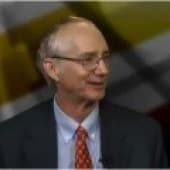The Fed had multiple opportunities to let the air out of unsustainable asset bubbles by notching interest rates higher and tapering its asset purchases (QE).
The Federal Reserve blew it by not normalizing interest rates a long time ago. The consensus in financial circles is the exact opposite: the Fed has blown it in the past by nudging rates up too early.
Let's examine the idea that the Fed can't possibly go wrong keeping interest rates at near-zero for as long as it takes to create inflation (the Keynesian Cargo Cult's talisman) and push unemployment below 6% (mission accomplished).
One problem with this "keep interest rates low forever" strategy is that it leaves the Fed no room to lower rates in the next recession. By keeping interest rates at near-zero for six long years of "recovery," the Fed is now facing a global recession with no real policy option to lower rates.
The Fed blew it by waiting six long years to even discuss raising rates.
Let's consider the impact on the real economy of a 1% rise in the Fed funds rate. The move from 0% to 1% is not very large in terms of its impact on monthly payments for borrowers. Borrowers with poor credit are paying in excess of 15% right now on credit cards and subprime auto loans, and many student loans are in the 7%-8% range. A 1% increase isn't going to impact these borrowers much.
As for mortgages--if a buyer can't afford a 1% notch up in interest rates, he/she had no business taking the mortgage in the first place. If a borrower has to stretch to the maximum to qualify, they shouldn't be borrowing the money in the first place.
Those who plead for zero-interest rates forever are saying that the U.S. economy is so fragile that the slightest tick up in interest costs will collapse the entire "recovery." If the economy is that dependent on marginal borrowers, then the "recovery" is bogus: if "growth" is all based on extending more credit to marginal borrowers, it is an extremely fragile expansion that is doomed by the inevitability of marginal borrowers defaulting.
The Fed's "extend and pretend" has only increased the fragility of the economy and guaranteed a larger systemic crisis in the future. Zero interest rate policy (ZIRP) has only encouraged moral hazard and asset bubbles blown by soaring corporate debt and margin debt.
Another reason the consensus wants 'ZIRP Forever' is to keep federal borrowing costs low, so the Treasury can borrow trillions of dollars at low rates of interest. If the costs of borrowing trillions more is low enough, there is no need for any politically painful debate about what the nation can afford: with nearly-free trillions, everything can be paid for with borrowed money.
What kinds of decisions are made when the federal credit card is unlimited? Poor decisions, of course--that's self-evident. No limits means no trade-offs or hard analysis of costs and benefits. This is a higher-order form of moral hazard, which means the consequences will not impact those taking the risks.
If you doubt this, give a teenager an unlimited credit card they don't have to pay and see how that works out.
A third reason the consensus wants 'ZIRP Forever' is that higher rates will further strengthen the U.S. dollar as capital will flow to the safety and positive yield of U.S. bonds. In the consensus view, a rising U.S. dollar is anathema, as it means the U.S. loses the race to the bottom of currency devaluation.
But all those begging for a devalued currency forget that no nation ever debased itself to prosperity. Yes, there is a trade-off to a stronger currency: exports to other nations will become more expensive when priced in debased currencies. But exports are a relatively modest percentage of GDP, and the decline in exports will be offset to some degree by the gains in purchasing power, as imports will decline in price.
If history offers any lesson on strong currencies and race to the bottom devaluations of currency, it's that nations with strong currencies prosper in the long haul and those who attempt to live off cheaper exports decline over time.
The Fed also blew it by extending quantitative easing for almost six years, inflating asset bubbles that must now be deflated one way or another. Rather than let the stock and housing markets find their own levels and adjust to the realities of a post-bubble world, the Fed has done everything in its power to reflate assets bubbles, lest the bloated, corrupt banking sector suffer the losses it so richly deserves.
The consensus believes the magical-thinking fantasy that asset bubbles can remain inflated forever, if only the Fed keeps interest rates at zero forever and stands ready to buy trillions of dollars of bonds, mortgages and stocks at the first sign that the bubbles are in danger of popping. Is this realistic? is there even one example in all of human history of a credit-bubble expanding forever? Of course not, but since Wall Street and the entire financial industry is totally dependent on asset bubbles for its livelihood, realism will lose out to greed every time.
The Fed had multiple opportunities to let the air out of unsustainable asset bubbles by notching interest rates higher and tapering its asset purchases (QE). Instead, it waited until the next global recession is already starting to consider what should have been done long ago.
